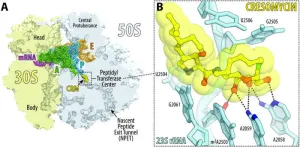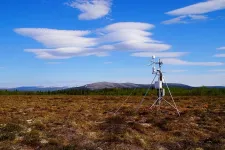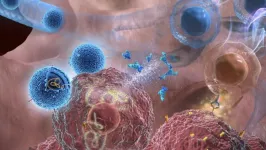(Press-News.org) A new antibiotic created by Harvard researchers overcomes antimicrobial resistance mechanisms that have rendered many modern drugs ineffective and are driving a global public health crisis.
A team led by Andrew Myers, Amory Houghton Professor of Chemistry and Chemical Biology, reports in Science that their synthetic compound, cresomycin, kills many strains of drug-resistant bacteria, including Staphylococcus aureus and Pseudomonas aeruginosa.
“While we don’t yet know whether cresomycin and drugs like it are safe and effective in humans, our results show significantly improved inhibitory activity against a long list of pathogenic bacterial strains that kill more than a million people every year, compared with clinically approved antibiotics,” Myers said.
The new molecule demonstrates an improved ability to bind to bacterial ribosomes, which are biomolecular machines that control protein synthesis. Disrupting ribosomal function is a hallmark of many existing antibiotics, but some bacteria have evolved shielding mechanisms that prevent legacy drugs from working.
Cresomycin is one of several promising compounds that Myers’ team has developed, with the goal of helping win the war against superbugs. They’ll continue advancing these compounds through preclinical profiling studies, supported by a $1.2 million grant from Combating Antibiotic-Resistant Bacteria Biopharmaceutical Accelerator (CARB-X). A Boston University-based global nonprofit partnership, CARB-X is dedicated to supporting early-stage antibacterial research and development.
The Harvard team’s new molecule draws inspiration from the chemical structures of lincosamides, a class of antibiotics that includes the commonly prescribed clindamycin. Like many antibiotics, clindamycin is made via semisynthesis, in which complex products isolated from nature are modified directly for drug applications. The new Harvard compound, however, is fully synthetic and features chemical modifications that cannot be accessed through existing means.
“The bacterial ribosome is nature’s preferred target for antibacterial agents, and these agents are the source of inspiration for our program,” said co-author Ben Tresco, a Kenneth C. Griffin Graduate School of Arts and Sciences student. “By leveraging the power of organic synthesis, we are limited almost only by our imagination when designing new antibiotics.”
Bacteria can develop resistance to ribosome-targeting antibiotic drugs by expressing genes that produce enzymes called ribosomal RNA methyltransferases. These enzymes box out the drug components that are designed to latch onto and disrupt the ribosome, ultimately blocking the drug’s activity.
To get around this problem, Myers and team engineered their compound into a rigidified shape that closely resembles its binding target, giving it a stronger grip on the ribosome. The researchers call their drug “pre-organized” for ribosomal binding because it doesn’t need to expend as much energy conforming to its target as existing drugs must do.
The researchers arrived at cresomycin using what they call component-based synthesis, a method pioneered by the Myers lab that involves building large molecular components of equal complexity and bringing them together at late stages – like pre-building sections of a complicated LEGO set before assembling them. This modular, completely synthetic system allows them to make and test not just one, but hundreds of target molecules, greatly speeding up the drug discovery process.
The stakes are clear. “Antibiotics form the foundation on which modern medicine is built,” said co-author and graduate student Kelvin Wu. “Without antibiotics, many cutting-edge medical procedures like surgeries, cancer treatments, and organ transplants, cannot be done.”
Myers’ component-based synthesis research received early support from Harvard’s Blavatnik Biomedical Accelerator, part of the Office of Technology Development, which awarded funding to Myers’ lab in 2013 to enable testing of drug compounds. The Office of Technology Development protected the Myers Research Group’s innovations and, along with the Blavatnik Biomedical Accelerator, will support the research team for the duration of the CARB-X agreement. The newly awarded CARB-X funding allows the researchers to continue profiling and optimizing drug leads.
“Funding and other support from groups like the Blavatnik Biomedical Accelerator and CARB-X are essential for the discovery and development of new antibiotics,” said Curtis Keith, the Harvard accelerator’s chief scientific officer. “These innovations from the Myers Research Group have the potential to yield new drugs that will one day meet a global health need.”
The published work was supported by the National Institutes of Health and the National Science Foundation.
END
Superbug killer: New synthetic molecule highly effective against drug-resistant bacteria
2024-02-15
ELSE PRESS RELEASES FROM THIS DATE:
With just a little electricity, MIT researchers boost common catalytic reactions
2024-02-15
CAMBRIDGE, MA — A simple technique that uses small amounts of energy could boost the efficiency of some key chemical processing reactions, by up to a factor of 100,000, MIT researchers report. These reactions are at the heart of petrochemical processing, pharmaceutical manufacturing, and many other industrial chemical processes.
The surprising findings are reported today in the journal Science, in a paper by MIT graduate student Karl Westendorff, professors Yogesh Surendranath and Yuriy Roman-Leshkov, and two others.
“The results are really striking,” says Surendranath, a professor of chemistry ...
Keeping telomerase in check
2024-02-15
The natural ends of chromosomes appear alarmingly like broken DNA, much as a snapped spaghetti strand is difficult to distinguish from its intact counterparts. Yet every cell in our bodies must have a way of differentiating between the two because the best way to protect the healthy end of a chromosome also happens to be the worst way to repair damaged DNA.
Consider the enzyme telomerase, which is responsible for maintaining protective telomeres at the natural ends of chromosomes. Were telomerase to seal off a broken strand of DNA with a telomere, it would prevent further repair of that break and delete essential genes. Now, a new study in Science describes how cells avoid ...
Competition for food drives the planet’s remaining mass migration of herbivores
2024-02-15
Upending the prevailing theory of how and why multi-species mass-migration patterns occur in Serengeti National Park, researchers from Wake Forest University have confirmed that the millions-strong wildebeest population pushes zebra herds along in competition for the most nutrient-dense grasses.
The study resulting from this research, “Interplay of competition and facilitation in grazing succession by migrant Serengeti herbivores,” appears today in the peer-reviewed journal Science.
For decades, biologists have believed the major grazing ...
UT Dallas Wind Energy Center to expand with new headquarters, resources
2024-02-15
The University of Texas at Dallas’ wind energy research programs have expanded rapidly in recent years, with labs, offices and facilities spread out on campus. In 2020 UT Dallas formed the Wind Energy Center, called UTD Wind, to bring its wind energy programs under one virtual umbrella.
Now, a new initiative will give UTD Wind a physical headquarters for the first time with additional labs, meeting areas and office space. The project also includes additional equipment for wind energy research and education.
UT Dallas has received $1.6 million through the federal Consolidated Appropriations Act to support the expansion, which will bring most of the center’s ...
More Aston University scholarships to encourage graduates from under-represented groups to work in artificial intelligence
2024-02-15
• Eleven scholarships worth £10k each for MSc Applied AI
• They are funded by the Office for Students (OfS)
• Aimed at graduates without a science, tech, engineering or maths degree.
Aston University is offering more opportunities to graduates who want a career in artificial intelligence (AI) but don’t have a science, technology, engineering or maths degree.
The scholarships are offered due to increased funding from the Office for Students (OfS). Each award is worth £10,000 and will be awarded to students enrolling ...
How is deforested land in Africa used?
2024-02-15
Africa's forested areas – an estimated 14 % of the global forest area – are continuing to decline at an increasing rate – mostly because of human activities to convert forest land for economic purposes. As natural forests are important CO2 and biodiversity reservoirs, this development has a significant impact on climate change and effects the integrity of nature. To intervene in a targeted manner in the interests of climate protection and biodiversity, there has been a lack of sufficiently good data and detailed knowledge ...
Studies with more diverse teams of authors get more citations
2024-02-15
Diverse research is more impactful in the business management field, with female influence growing stronger in the past decade, finds a new study from the University of Surrey.
The study analysed all articles published in the last 10 years (January 2012 to December 2022) in the influential Journal of Management Studies.
The empirical analysis examined three key aspects of teams’ diversity:
Internationality (how international is mix of authors),
Interdisciplinarity (how many different fields of study they come from),
Gender ...
UC Irvine researcher co-authors ‘scientists’ warning’ on climate and technology
2024-02-15
Irvine, Calif., Feb. 15, 2024 – Throughout human history, technologies have been used to make peoples’ lives richer and more comfortable, but they have also contributed to a global crisis threatening Earth’s climate, ecosystems and even our own survival. Researchers at the University of California, Irvine, the University of Kansas and Oregon State University have suggested that industrial civilization’s best way forward may entail embracing further technological advancements but doing so with greater awareness of their potential drawbacks.
In a paper titled “Scientists’ Warning on Technology,” published recently in the Journal of Cleaner ...
Methane emissions from wetlands increase significantly over high latitudes
2024-02-15
– By Julie Bobyock
Wetlands are Earth’s largest natural source of methane, a potent greenhouse gas that is about 30 times more powerful than carbon dioxide at warming the atmosphere. A research team from the Department of Energy’s Lawrence Berkeley National Laboratory (Berkeley Lab) analyzed wetland methane emissions data across the entire Boreal-Arctic region and found that these emissions have increased approximately nine percent since 2002.
Livestock and fossil fuel production are well studied for their role in releasing tons of methane per year into the atmosphere. Although more uncertain, quantifying natural wetlands emissions is important to predicting climate ...
Study finds new inhalable therapy is a big step forward in lung cancer research
2024-02-15
Lung cancer is one of the most common cancers and has one of the lowest survival rates in the world. Cytokines, which are small signaling proteins, such as interleukin-12 (IL-12), have demonstrated considerable potential as robust tumor suppressors. However, their applications are limited due to a multitude of severe side effects.
In a paper published Jan. 11 by Nature Nanotechnology, Biomedical Engineering Professor Ke Cheng and his research group demonstrate that using nanobubbles, ...





